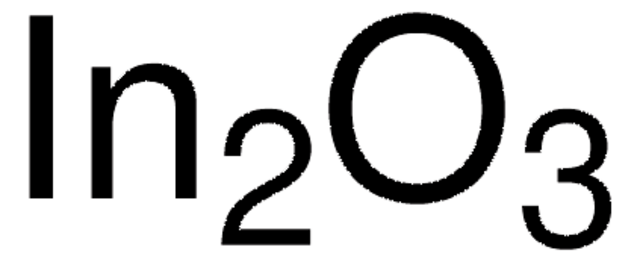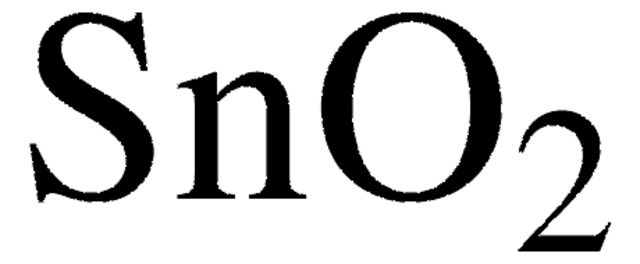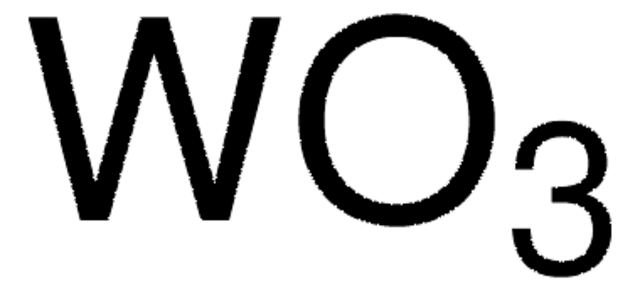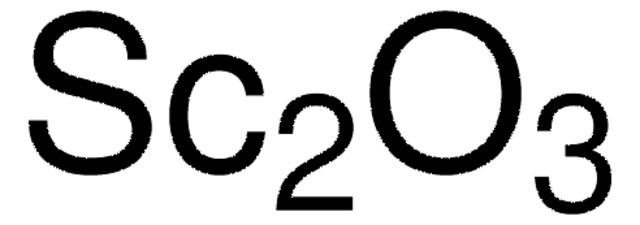Wichtige Dokumente
289418
Indium(III)-oxid
99.99% trace metals basis
Synonym(e):
Diindium trioxide, Indium sesquioxide
About This Item
Empfohlene Produkte
Dampfdruck
<0.01 mmHg ( 25 °C)
Qualitätsniveau
Assay
99.99% trace metals basis
Form
powder
Eignung der Reaktion
reagent type: catalyst
core: indium
Dichte
7.18 g/mL at 25 °C (lit.)
Anwendung(en)
battery manufacturing
SMILES String
O=[In]O[In]=O
InChI
1S/2In.3O
InChIKey
SHTGRZNPWBITMM-UHFFFAOYSA-N
Suchen Sie nach ähnlichen Produkten? Aufrufen Leitfaden zum Produktvergleich
Allgemeine Beschreibung
Anwendung
- Comparative analysis on application conditions of indium (III) oxide-reinforced glasses in nuclear waste management and source transportation: A Monte Carlo study: This research explores the use of indium (III) oxide-reinforced glass for radioactive waste containment, highlighting its effectiveness and potential in nuclear waste management (ALMisned et al., 2023).
- Double-shelled hollow rods assembled from nitrogen/sulfur-codoped carbon coated indium oxide nanoparticles as excellent photocatalysts: Discusses the synthesis and application of indium oxide nanoparticles in photocatalysis, demonstrating significant enhancements in environmental cleanup technologies (Sun et al., 2019).
- Black indium oxide a photothermal CO2 hydrogenation catalyst: Investigates black indium oxide for its use in photocatalytic CO2 reduction, a critical process for sustainable energy and chemical synthesis (Wang et al., 2020).
- Material proposal for 2D indium oxide: This study proposes two-dimensional indium oxide, discussing its material characteristics and potential applications in electronics and optoelectronics (Kakanakova-Georgieva et al., 2021).
- Purification of indium by solvent extraction with undiluted ionic liquids: Examines the processes of extracting and purifying indium using green chemistry approaches, contributing to more sustainable practices in materials processing (Deferm et al., 2016).
Lagerklassenschlüssel
11 - Combustible Solids
WGK
WGK 3
Flammpunkt (°F)
Not applicable
Flammpunkt (°C)
Not applicable
Persönliche Schutzausrüstung
dust mask type N95 (US), Eyeshields, Gloves
Hier finden Sie alle aktuellen Versionen:
Besitzen Sie dieses Produkt bereits?
In der Dokumentenbibliothek finden Sie die Dokumentation zu den Produkten, die Sie kürzlich erworben haben.
Kunden haben sich ebenfalls angesehen
Artikel
Spectral conversion for solar cells is an emerging concept in the field of photovoltaics, and it has the potential to increase significantly the efficiency of solar cells. Lanthanide ions are ideal candidates for spectral conversion, due to their high luminescence efficiencies and rich energy level structure that allows for great flexibility in the upconversion and downconversion of photons in a wide spectral region (NIR-VIS-UV).
Unser Team von Wissenschaftlern verfügt über Erfahrung in allen Forschungsbereichen einschließlich Life Science, Materialwissenschaften, chemischer Synthese, Chromatographie, Analytik und vielen mehr..
Setzen Sie sich mit dem technischen Dienst in Verbindung.










